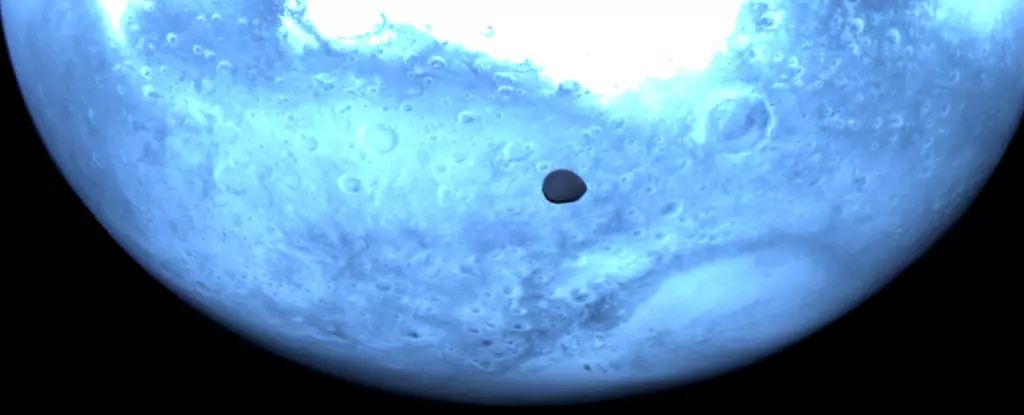As humanity continues to advance its exploration of outer space, the European Space Agency (ESA) has taken monumental steps with its HERA mission. Designed to investigate the aftermath of a historic asteroid collision, the spacecraft recently conducted a flyby of Mars, acquiring unprecedented images of the planet’s enigmatic moon, Deimos. This flyby was not just serendipitous; it was part of a calculated maneuver meant to conserve fuel and gain valuable data on both the Martian environment and asteroids that could potentially threaten Earth.
Set against the backdrop of the asteroid belt situated between Mars and Jupiter, HERA is en route to the asteroid Dimorphos, which lies approximately 11 million kilometers from Earth. The collision of a separate NASA spacecraft, DART, with Dimorphos in 2022 marked a pivotal moment in the history of planetary defense, and now HERA’s mission to assess the event’s impact adds a layer of urgency to our understanding of asteroids. This mission opens up vital dialogue about our planetary defenses and highlights the necessity for proactive stances against potential cosmic threats.
A Technological Marvel in Motion
On a brisk Wednesday, the HERA spacecraft employed Mars’ gravitational field to gain momentum, achieving speeds of 33,480 kilometers per hour while skimming as low as 5,600 kilometers from the Martian surface. This gravity assist is a testament to the ingenuity of modern aerospace engineering— a method that maximizes resources while gathering significant scientific data. During this fleeting encounter, HERA captured around 600 images, including striking visuals of Deimos, the smaller, less famed of Mars’ two moons.
Deimos itself is a peculiar object in our celestial neighborhood, measuring a mere 12.5 kilometers across and exhibiting a lumpy, irregular shape. Its origins remain hotly debated among scientists, with theories ranging from captures of asteroids by Mars’ gravity to fragments ejected during colossal impacts on the Martian surface. The latest images obtained through HERA elevate this discourse by providing fundamental data that could ideally clarify the moon’s origins as well as the broader celestial context surrounding Mars.
Deciphering Celestial Secrets
What makes HERA’s findings even more compelling is the promise of advanced instruments like the “HyperScout” and specialized thermal infrared imagers. These technologies aim to scrutinize colors beyond human perception, thus enhancing our grasp of planetary compositions and phenomena. A striking result of this infrared imaging has been the portrayal of Mars in various hues, including intriguing shades of blue—a testament to the capabilities of modern science and technology.
The images captured by HERA not only enrich our understanding of Deimos’s composition but also serve as pieces in the larger puzzle of Mars’ geological and celestial past. Researchers like Marcel Popescu at the Astronomical Institute of the Romanian Academy accentuate the importance of these insights in gradually peeling back the layers of astrobiological realities both on Mars and in its orbit.
Planetary Defense: A Global Priority
As HERA carefully maneuvers its path toward Dimorphos, it simultaneously brings attention to the pressing concern of planetary defense. The need to develop and optimize methods for mitigating asteroid impacts is more crucial than ever, especially given the recent identification of asteroids like 2024 YR, which posed a tangential risk of impacting Earth. While the chances have since diminished to nearly zero through renewed observations, this incident highlights the urgency of vigilance and proactive measures in global space monitoring efforts.
In tandem with HERA, the ESA is poised to develop a second mission focused on the larger asteroid Apophis, set to fly perilously close to Earth in 2029. Should the Ramses mission receive approval, it signals a committed step toward an enhanced understanding of near-Earth objects, potentially safeguarding global civilization from existential threats.
The Future is Bright
In an era of unprecedented exploration and the race to demystify space, the HERA mission is lighting the way for future discoveries. As we grapple with the looming reality of cosmic threats, missions like HERA will not only inform us about asteroids and moons but also sculpt strategies for planetary defense. Through commitment, innovation, and scientific inquiry, humanity stands to not only decode the mysteries of our solar system but also ensure its own survival amidst the chaos of the cosmos.

